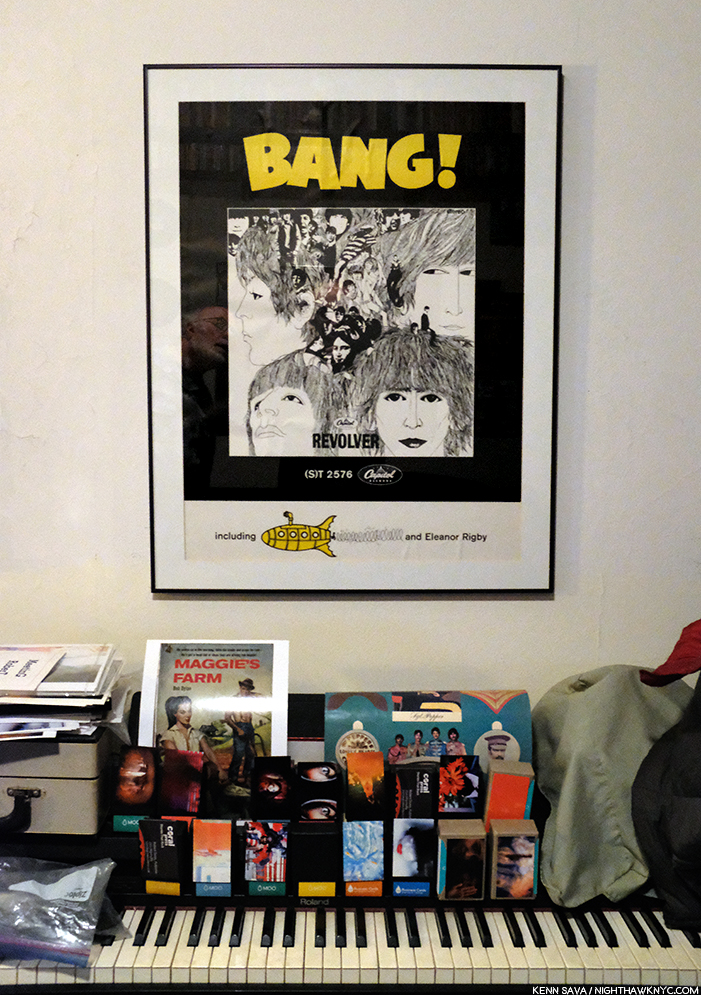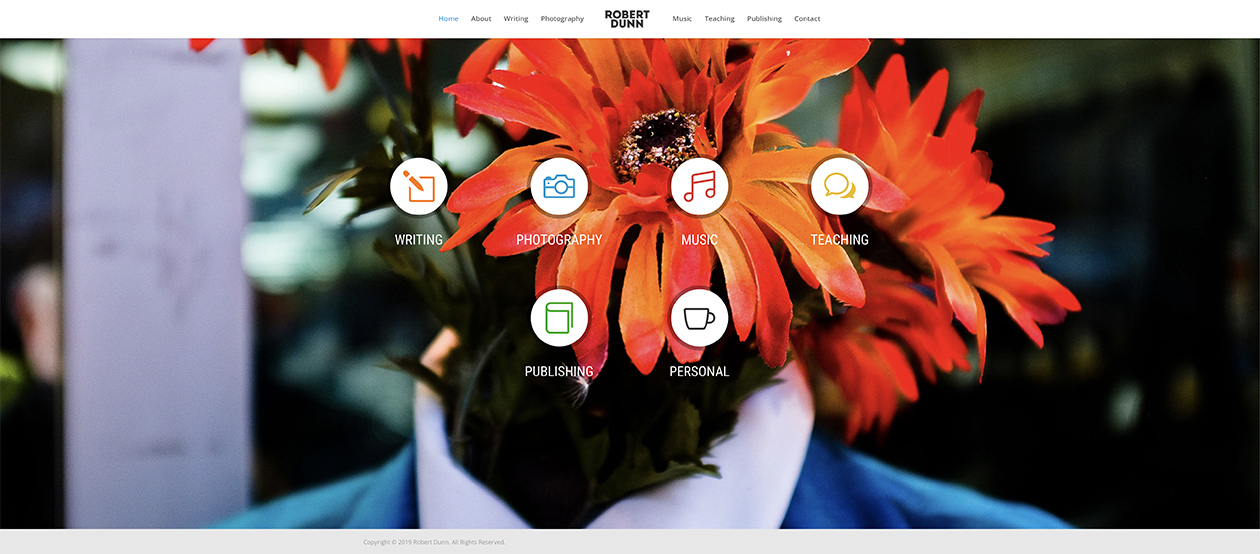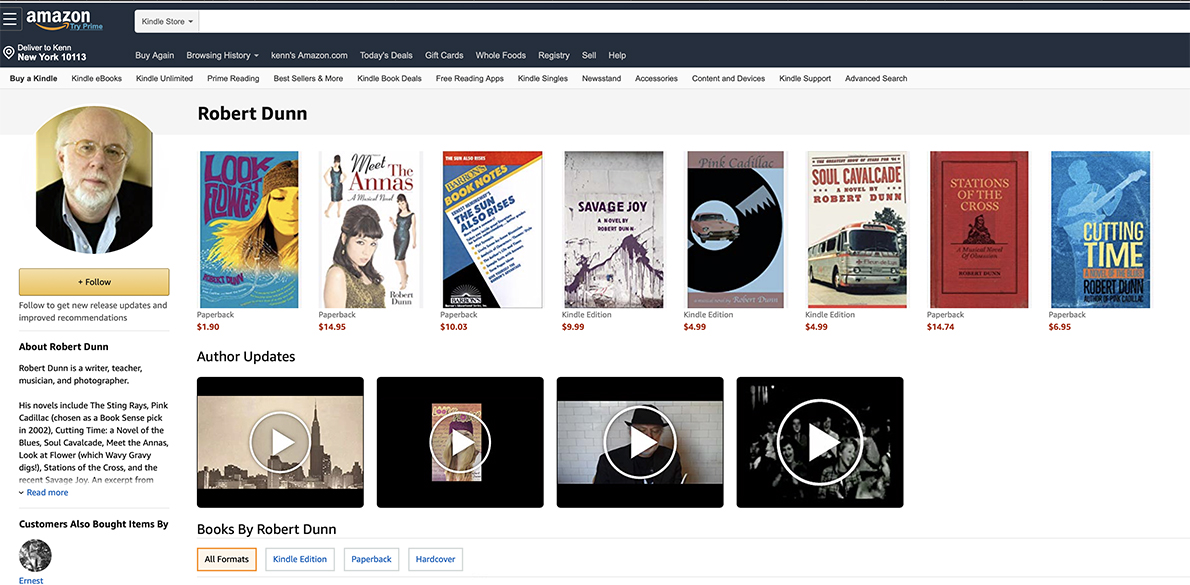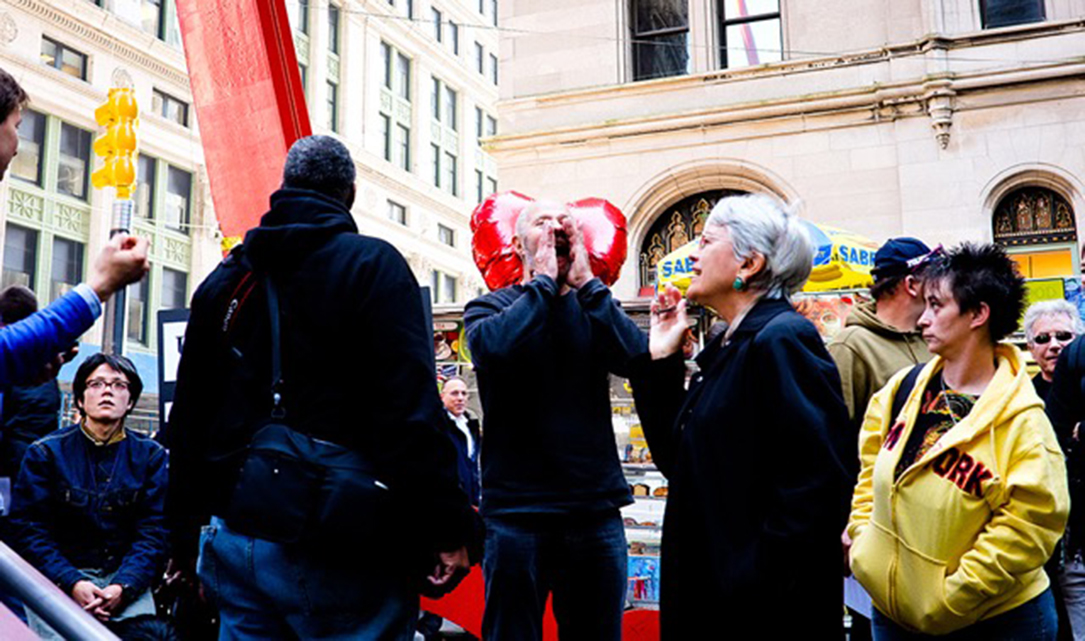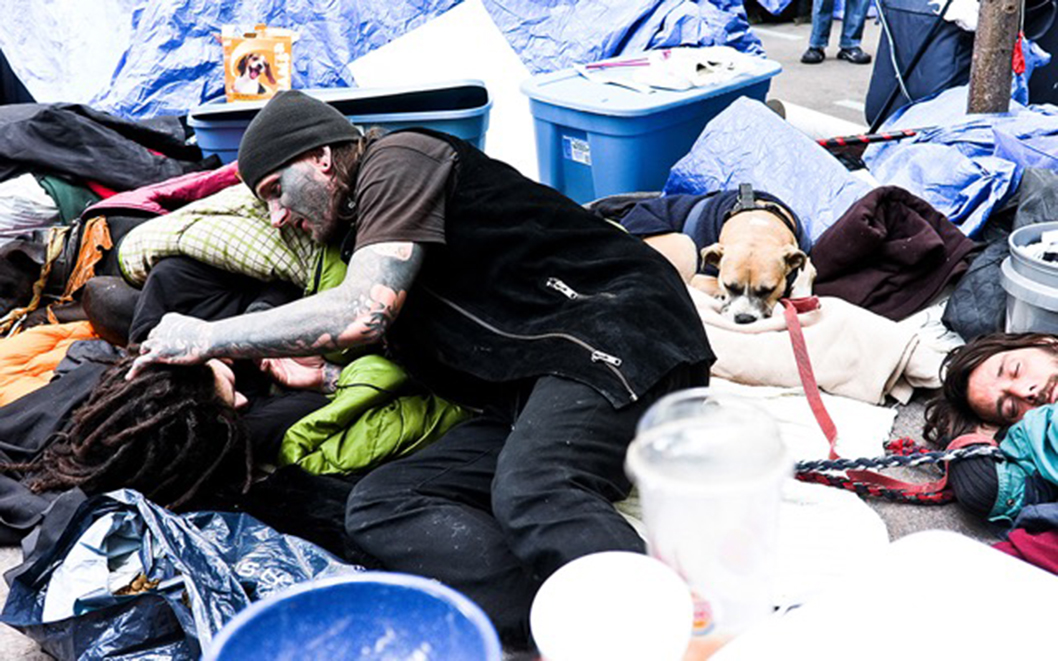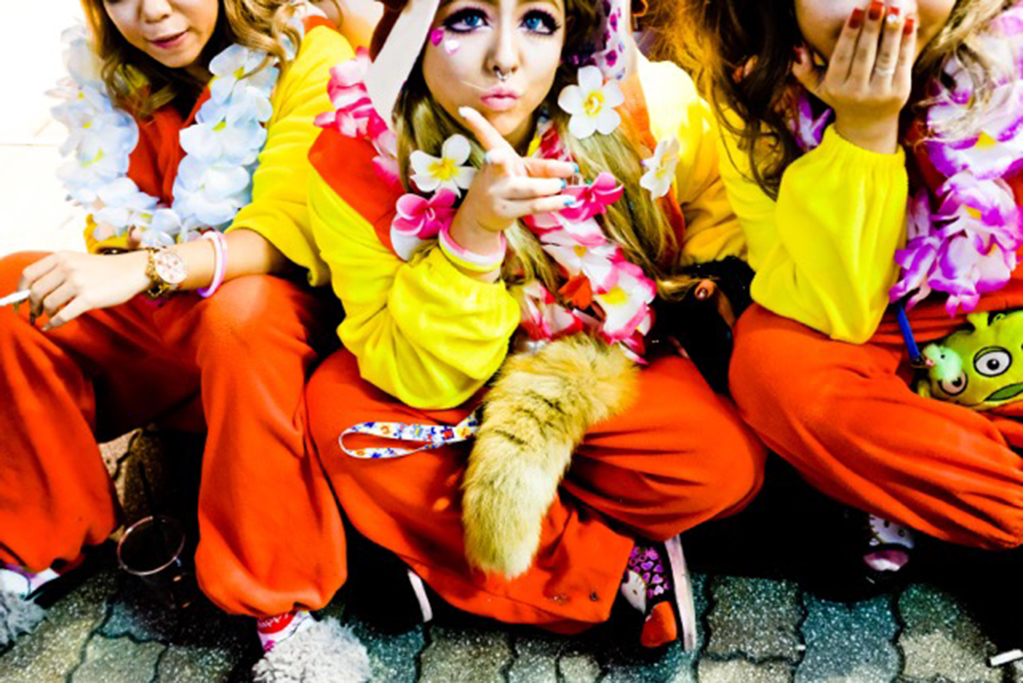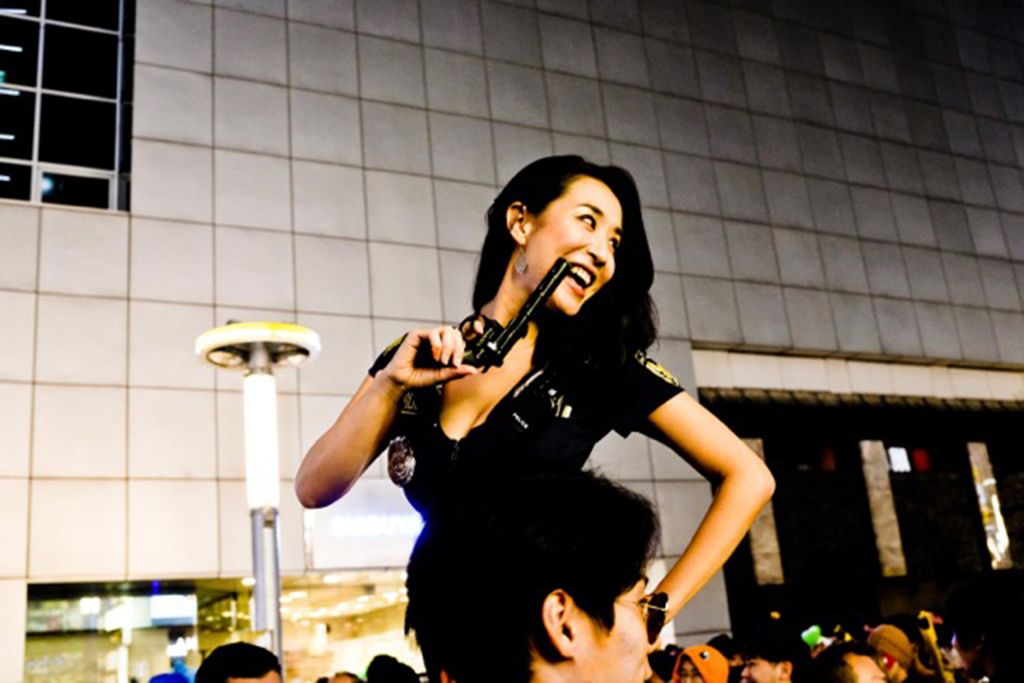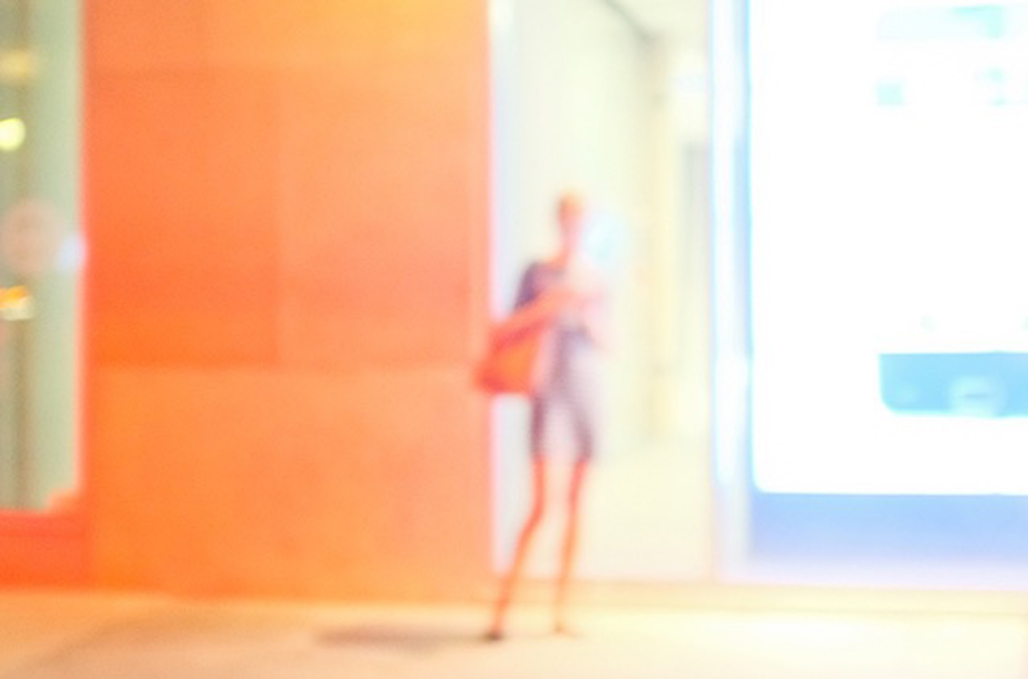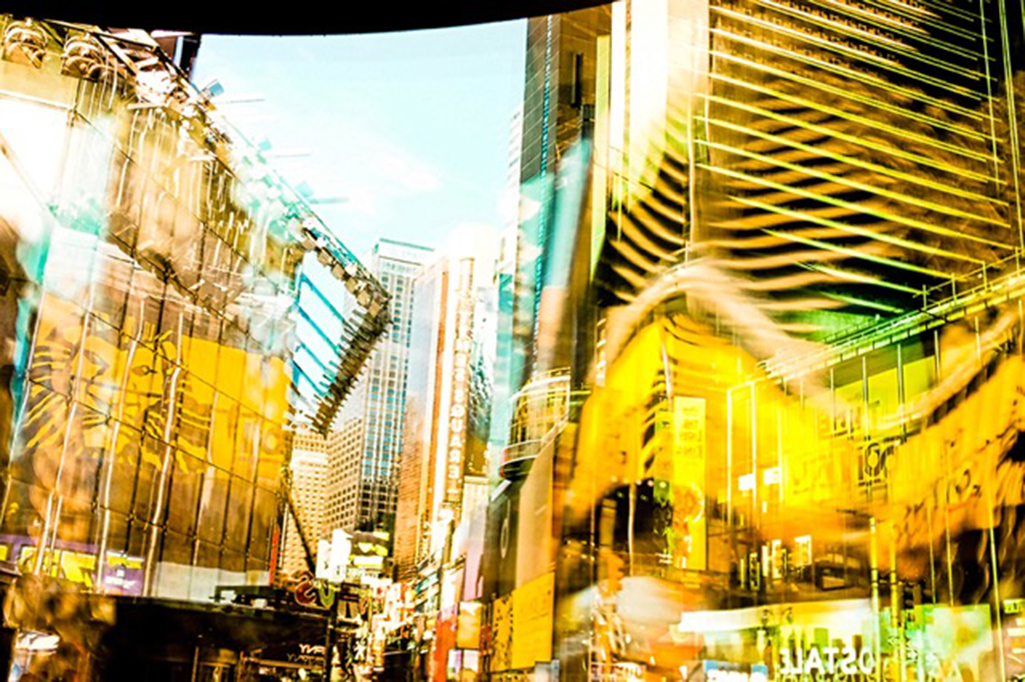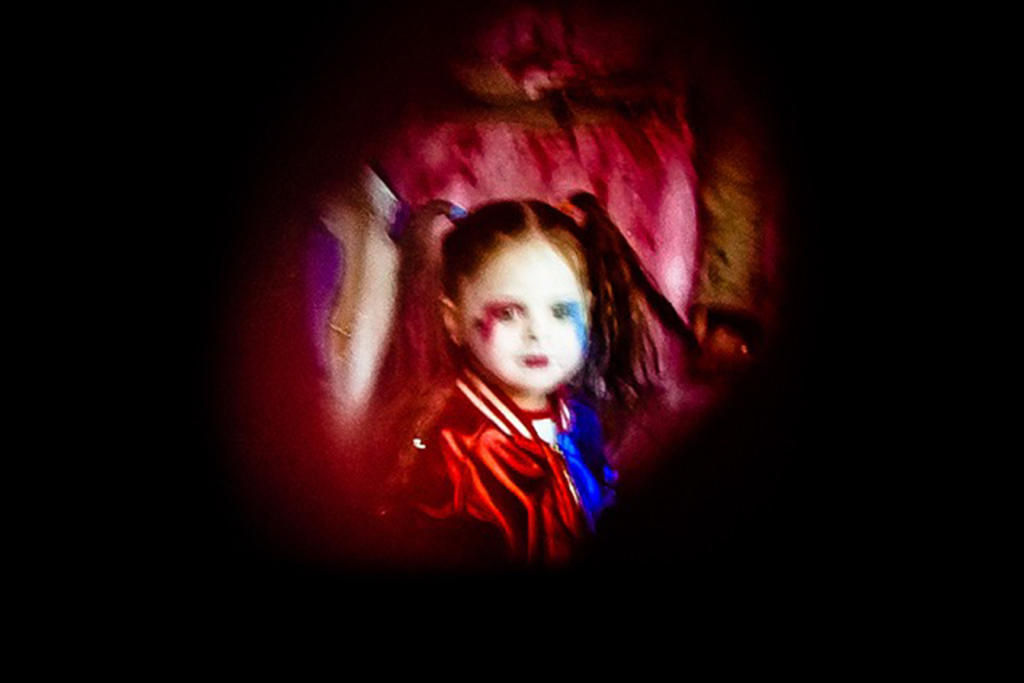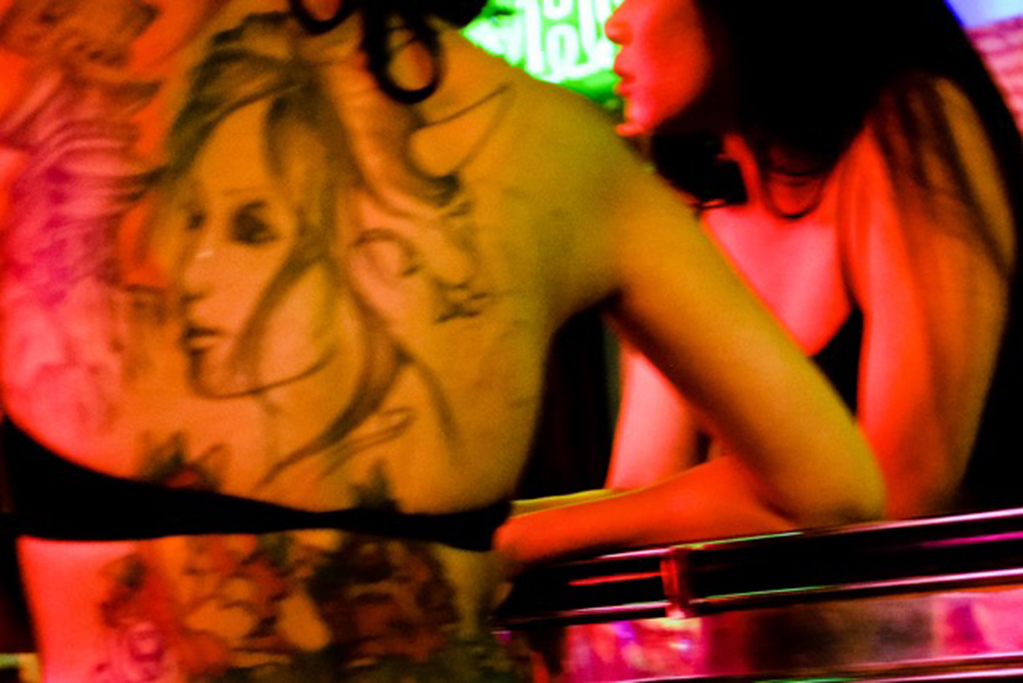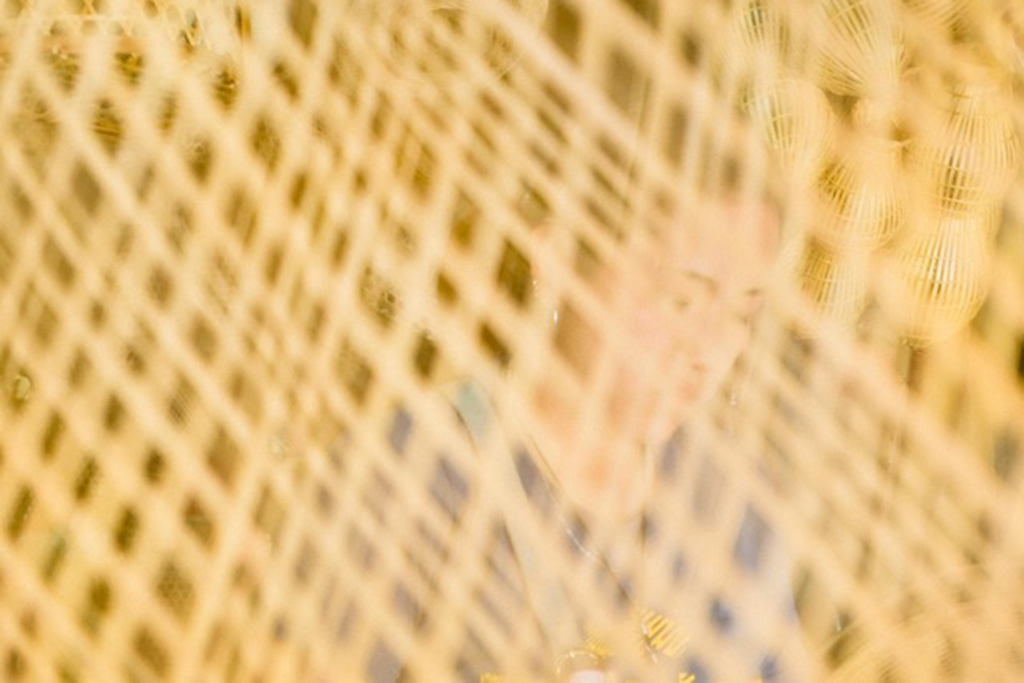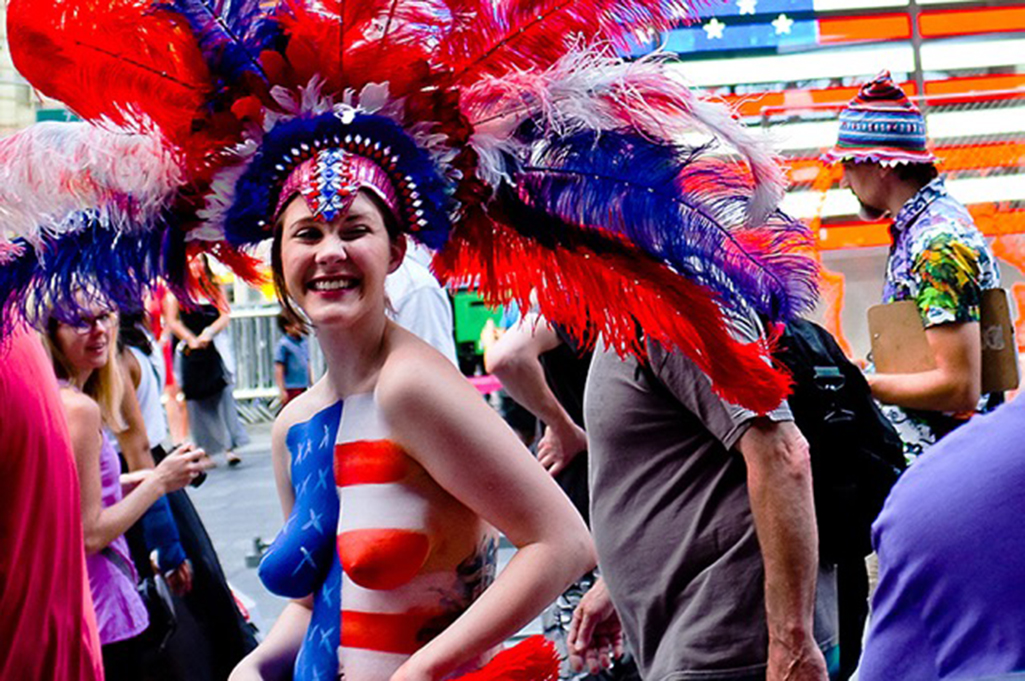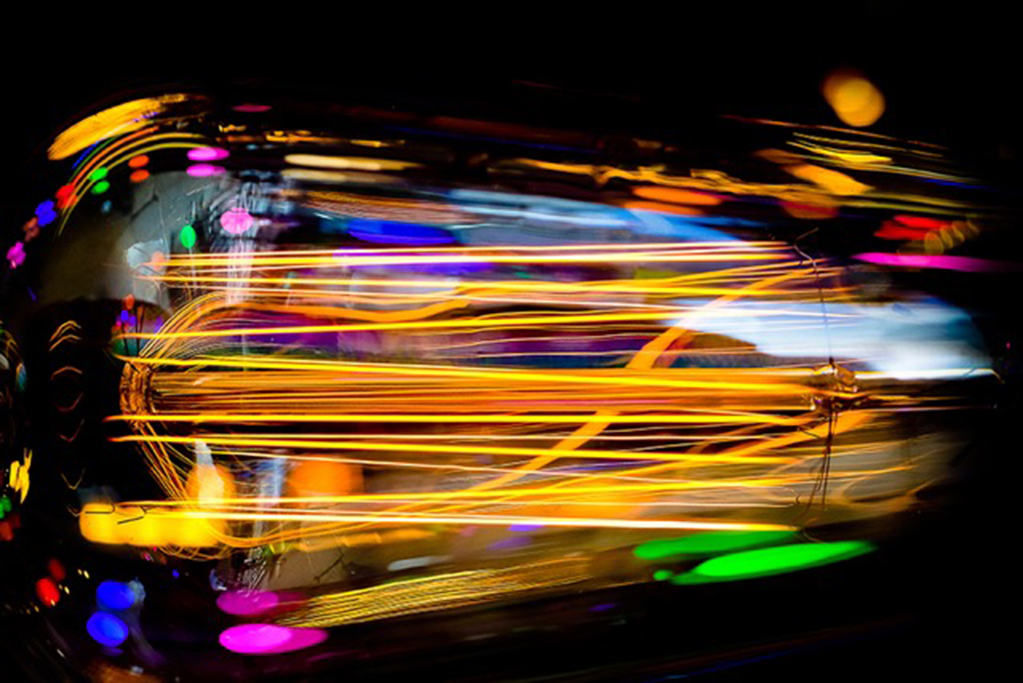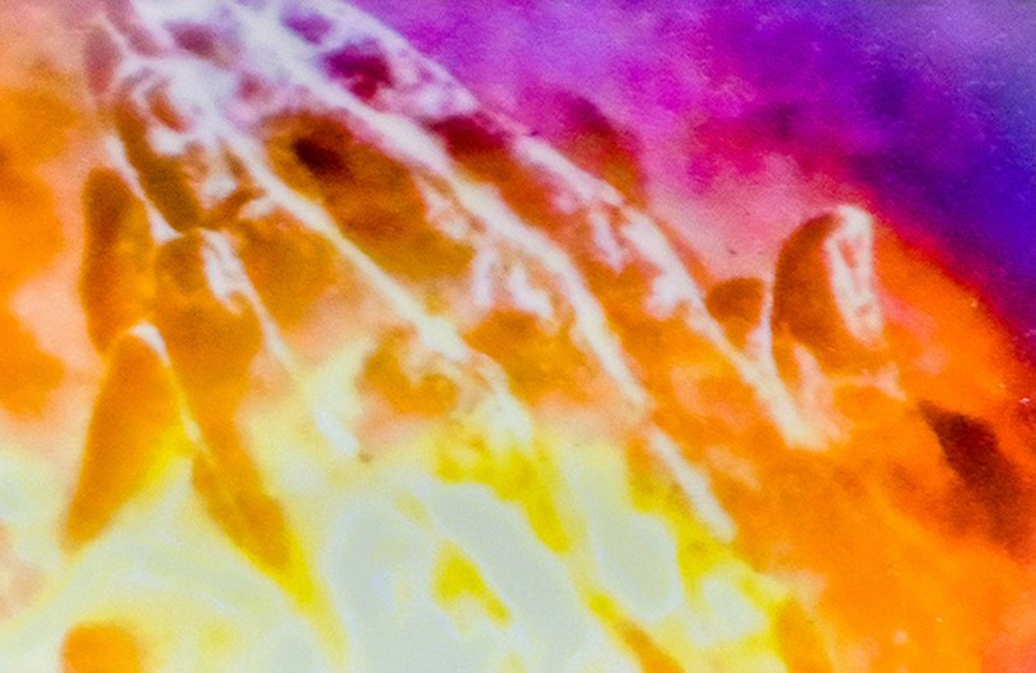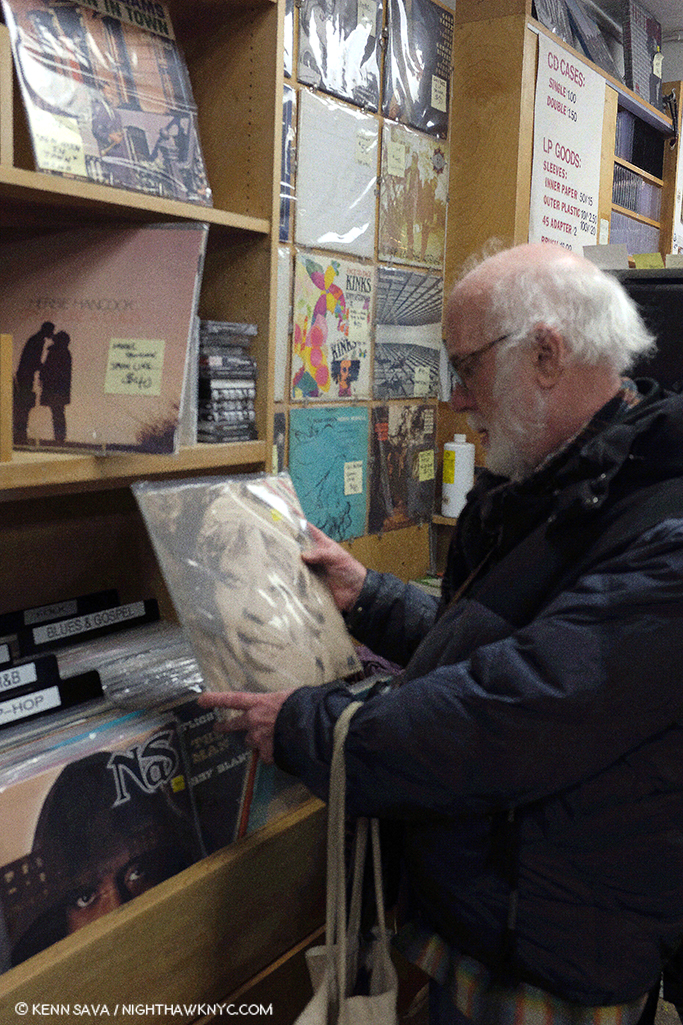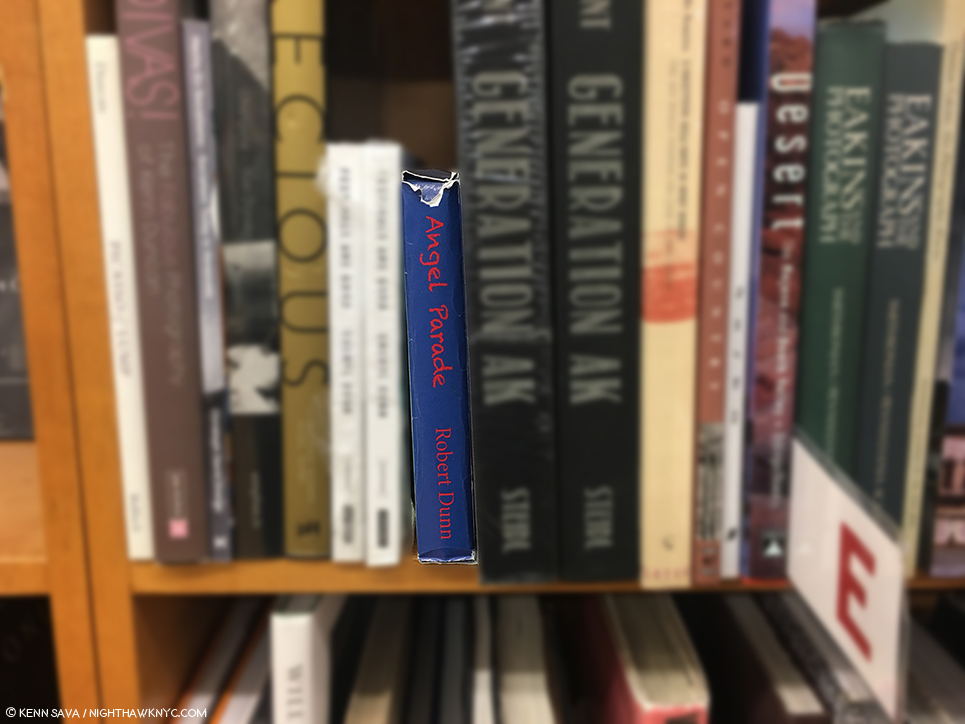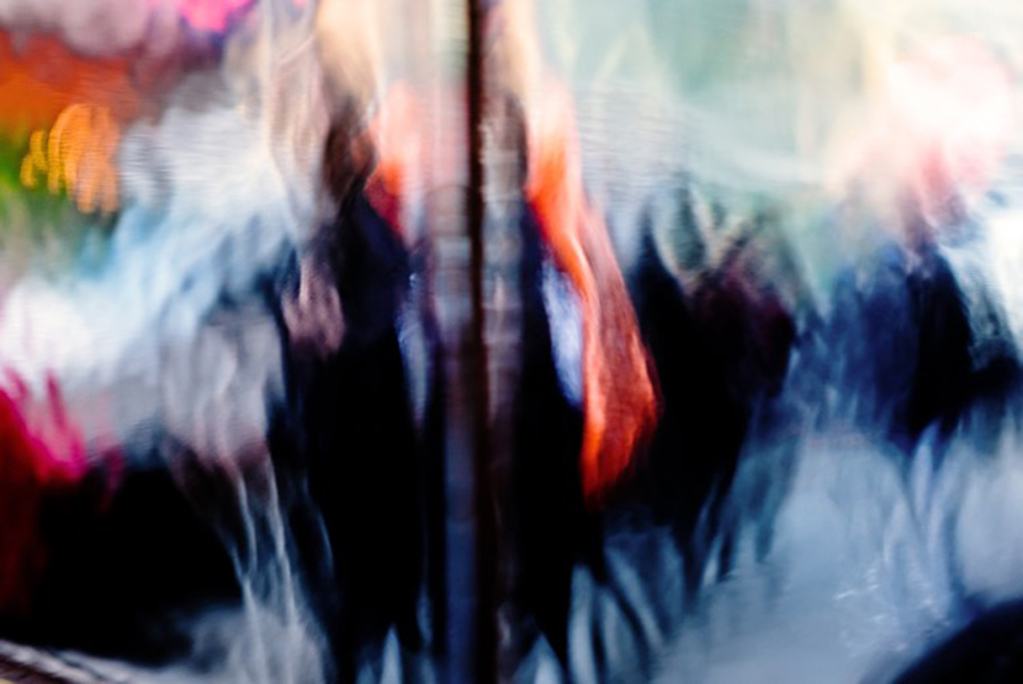Written & Photographed by Kenn Sava (*unless otherwise credited)
Poor Tomorrow. It has no idea what Robert Dunn will bring to it. Given his versatility and endless inventiveness, all bets are off.
That’s the feeling I get from looking at his Photography. My Post, Robert Dunn’s Revolver, is an overview of the multi-dimensional Robert Dunn’s Photography and PhotoBook Publishing. In preparing it, Robert was kind enough to, somehow, find some time in his busy life to answer some questions for me, thereby giving readers a chance to hear directly from this talented man, who generally “speaks” only through his work, unless you’re among the lucky few who take his classes at The New School on Writing, or “Writing the Photobook.” So, without further adieu, before tomorrow gets here, Robert Dunn-
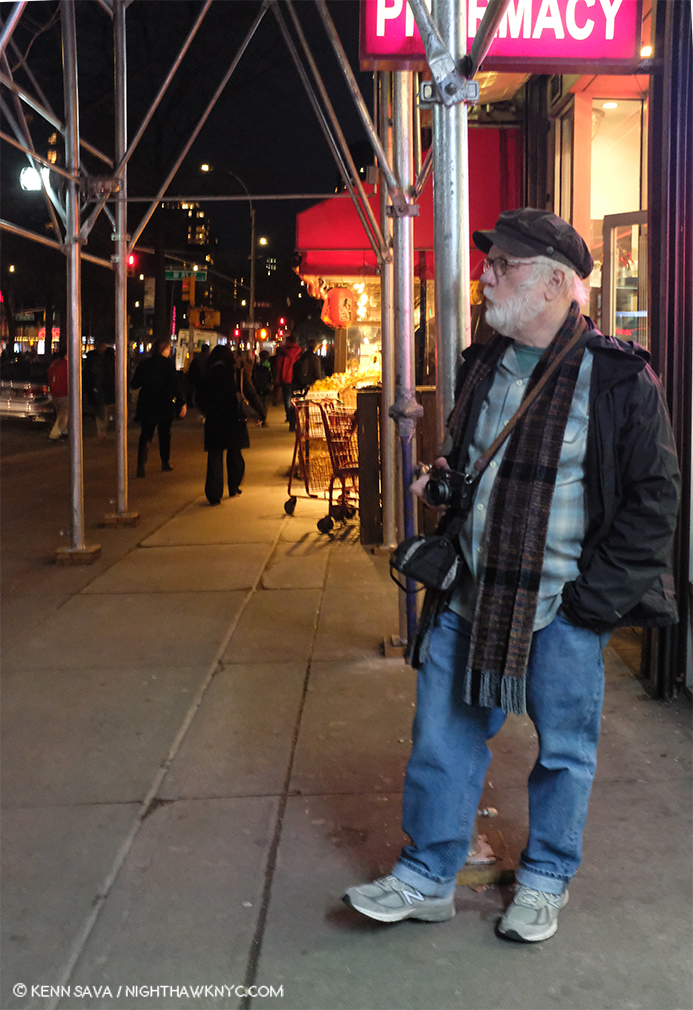
Robert Dunn on Broadway on the Upper West Side, surveys the scene, camera at the ready, February, 2019.
Kenn Sava (KS)- Bob, You’ve had successful careers as a Musician, Writer and a Teacher. Why did you turn to Photography? Was there a moment, event or influence that triggered its beginning?
Robert Dunn (RD)- Kenn, first off, thanks for letting me talk about my work for your impressive site.
Here’s my artistic, well, arc, I guess. When I was 13, I first heard Bob Dylan, immediately wanted to be him, learned guitar, wrote pretty good songs, and quickly found out I couldn’t sing at all. Turned out my strengths then were with the lyrics, so I got into literature, immediately wanted to be James Joyce, and wrote fiction and some poetry. (Surprisingly, my first publication was a poem in The New Yorker.) For the last few decades all I’ve written are novels.
Back in the ’80s, though, I got really interested in photography—especially color photography, inspired by William Eggleston. I pursued it pretty seriously, up to the point at which to make a good-sized high-end print, I’d either do that or pay the rent in my East Village apartment. So photography fell by the wayside. (One good thing about writing, all you needed to buy then was paper; today, not even that.)
I did purchase a few photobooks back then, and when I got back into studying and collecting photobooks, I was pleased to see the books I’d bought and cherished were Frank’s “Americans,” Eggleston’s “Guide,” Susan Meiselas’s “Nicaragua,” and Bill Burke’s “I Want to Take Picture.”
But for what I do now, my interest was specifically renewed by a review of the then-new Fuji X100 camera I read in the Times. I immediately said to myself, I used to love taking pictures, and this camera sounds perfect. So after a little this and that, I was able to get one. (They were like new iPhones at first, sold out everywhere.) I went out that weekend to try it out and startled myself with what I was shooting.
Basically, the camera seemed to have a kind of mind of its own, and was taking pictures that captured light and color in a way I could hardly believe—and that I loved.
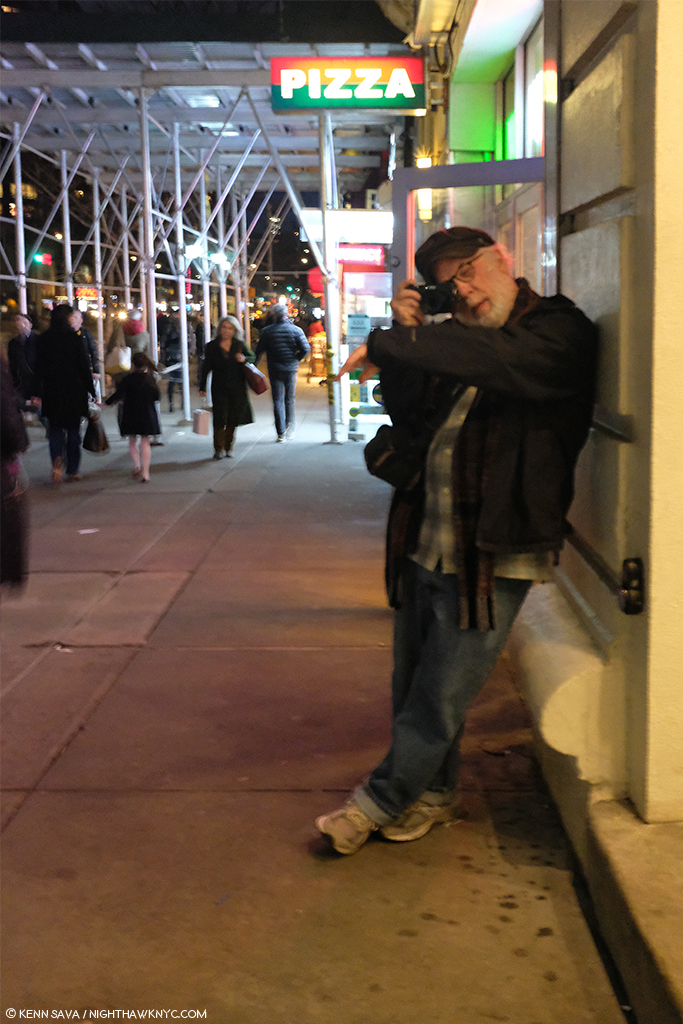
Coincidentally, I use the Fuji X100F, too, so I was particularly interested in how Mr. Dunn uses his. I’m not sure I was expecting to see this, however.
So, yes, that’s where it all really started, with that first Fuji camera.
KS- What’s the connection between your Novels and your Photography, or are they both just outlets for different sides of your creativity?
RD- A very intriguing question. I like to think that if I’m good at photography, it’s because years of writing fiction has taught me a few basic things, perhaps most important how to see as much as possible. I remember a lunch many, many years ago with a Knopf editor, Alice Quinn, who was a mentor back then. (She later was The New Yorker poetry editor.) I told her that day, “I think I’m finally learning how to see not just a person’s front, but behind them, too. See all the way around them.” I think I also meant much deeper inside a character, but in essence my idea was that I was expanding my range and depth of simple sight.
And that’s what my photography is. Walking around taking in as much of what’s going on as I can, and trying my best to capture what’s most interesting about what’s there. If in the shots I take of people, I can see—and capture—some essence of their personality, their soul, then I think I’ve made a pretty good picture.
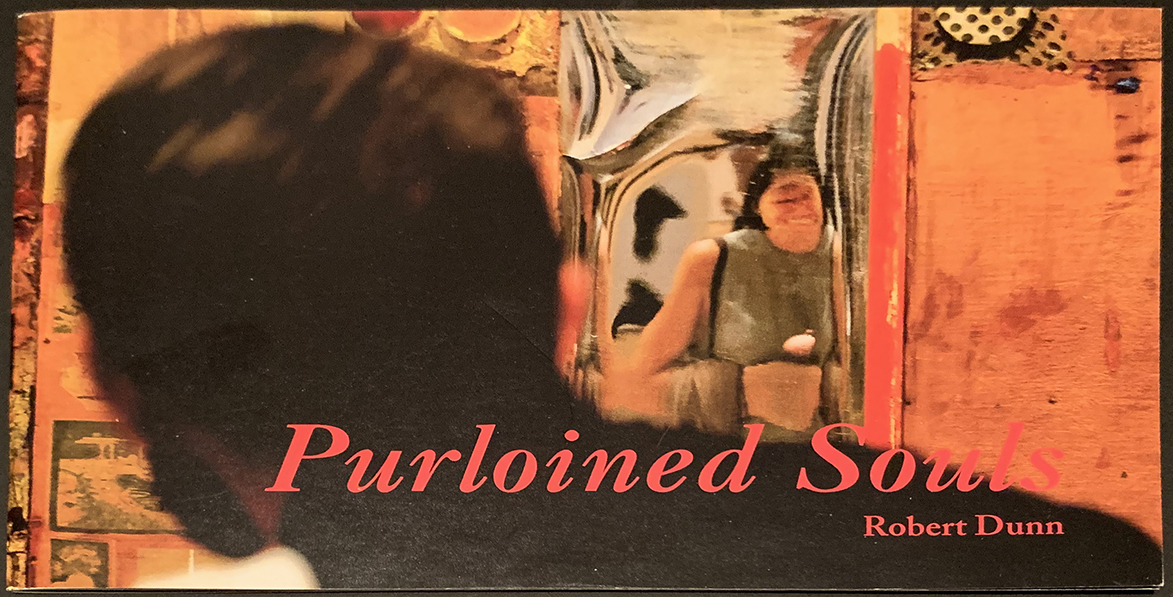
Purloined Souls, by Robert Dunn.
Oh, and one unexpected connection between my fiction writing and my first photobook, OWS—pictures I shot at Occupy Wall Street, back in 2011. I initially went down there to donate a few copies of my hippie-chick novel, Look at Flower, to their free library. The thing is, I went to college at UC Berkeley back in the early ’70s, and the air, the ambience, in Zuccotti Park immediately hit me with whiffs of those riotous years at Cal—a vibe I truly hadn’t experienced since. I got jazzed, and started shooting photos, then going back every week. There were a lot of photographers down there, but I made sure I didn’t shoot in any of the directions they were all shooting; I found my own details, moments, etc. OWS came out in 2012, and went into a second printing quickly. And a photo from it was in an ICP show.
KS- Is there something you particularly love about being a Photographer?
RD- Yes, and it ties in with my answer to the last question. I love almost everything about my photographic work, but at bottom I think I’m most psyched about the place my head goes into when I’m out with my camera on the streets, trying to take in everything around me, every telling gesture, every detail, incongruence, hint of something more than just what appears to be there. It’s a little like my fiction writing, when I get so lost in writing that time has no presence, and the story is all I know.
My photo taking, though, is an especially Zen sort of thing, where I’m out walking around totally in the moment, perceiving the whole world moving around me, always looking for a good shot. All the time I’m telling myself, Hmmnn, is that interesting? Nope. How about that? Nope. Is that worth shooting? Nope. Nope. No … oh, wait, that might be worth a click of the shutter.
All this happens in nanoseconds. Being in the world, yet not of it—trying to capture what most interests me in my camera. Losing myself to that, but also being fully there at the same time.
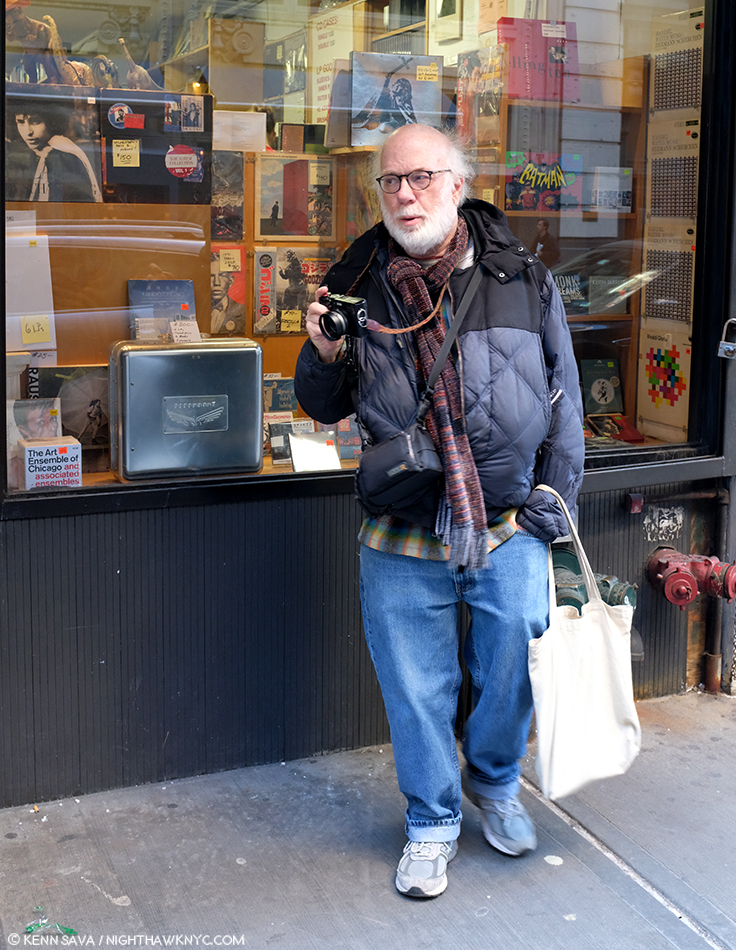
Robert Dunn is ALWAYS aware of his surroundings and the potential for images in the moment. During the no more than 2 minutes we stood outside Academy Records, he was looking everywhere at once, camera in hand. February, 2019.
KS- You seem to be a model of a D.I.Y. Artist, from creating the work to releasing your Photobooks and overseeing their sales through Coral Press. What’s been the hardest part of that for you?
RD- I love making photobooks; indeed, I have books that almost nobody has seen, just because I have an idea, fulfill it, and turn it into a book. Far and away the hardest part of this for me is getting books out there. Into stores, into people’s hands. Every day, I’m happy—no, I need—to take pictures. Not every day do I feel like walking into some place and trying to get them to sell my work.
That said, things have worked out pretty well. My self-made books are in numerous museum libraries, including MoMA, ICP, the Brooklyn Museum, and the Tokyo Photographic Museum. They’ve been for sale at PS1 MoMA, Dashwood, the Strand, and the ICP bookstore, among other places (Note- See BookMarks at the end for a list of some).
Funny story about ICP, and selling your own books in general. I took one of my early Angel Parade series there, and the woman in charge said she’d love to take copies, then said that she thought they should be priced at $18. I said, “You take fifty percent of each sale, right?” She nodded. Then I said, “O.K., each book costs me $12 to print, so if you sell one, I’ll get nine dollars from you. That way, hmnnn, I’m only paying people three dollars to own my books.” She shrugged, and I immediately said, “Good deal—hope you sell a lot!” Hey, it was the International Center of Photography. I meant it.
KS- Along the way, did anyone teach you any of this (Photography, digital technology, printing & publishing), or are you entirely self-taught?
RD- Well, nobody taught me anything, as in my taking a class to learn the stuff you ask about. I have been taking over and over, and really enjoying, a Master Printing course at ICP with Ben Gest; but even for that, when the requirement was great facility with Photoshop, I basically didn’t have very much, so I faked it till I got it.
But I never took a How to Photograph–type course. I wanted to learn by doing it myself, studying photographers who move me, and trusting my own intuitive artistic understanding more than anything anyone could tell me.
Same with writing. I never studied writing, though I was a Lit major in college. But I also was fortunate enough to be around some impressive writers back when I was getting going. My first-ever real job was at The New Yorker magazine. While I worked there, I was one of the redoubtable film critic Pauline Kael’s assistants, and for the final three years of the great novelist Bernard Malamud’s life, I was his paid assistant. Indeed, after he passed I was given his desk, and to this day I do all my work at it.
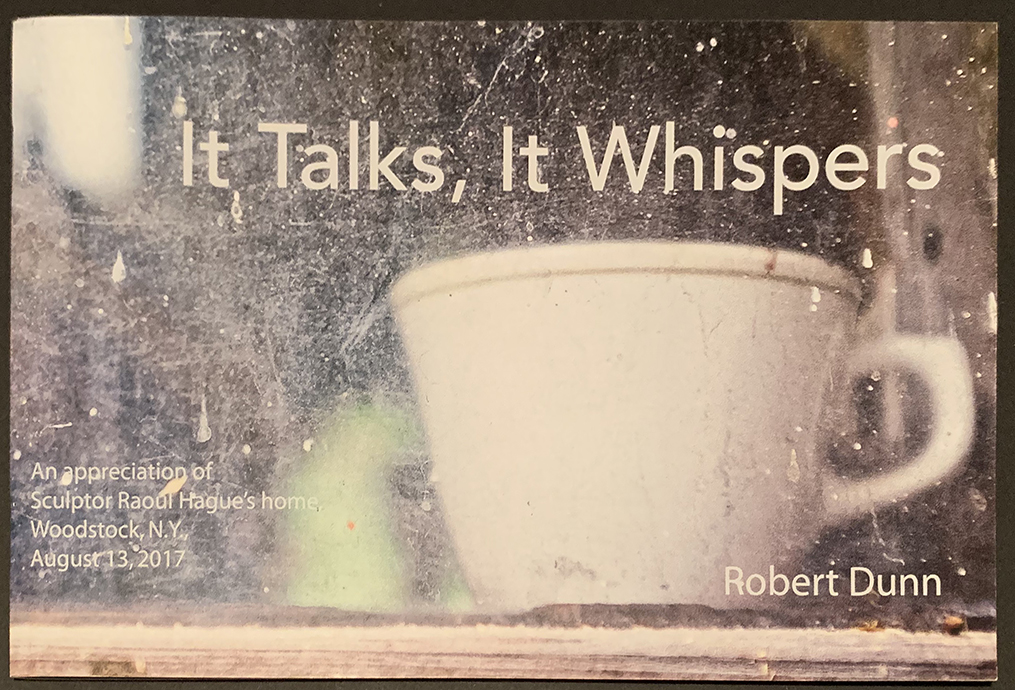
It Talks, It Whispers by Robert Dunn, one of my personal favorites of the books I’ve seen of his yet so far, is in ANOTHER style than those I showed in Revolver.
KS- How did being a published Novelist help you with your PhotoBooks?
RD- Gave me experience on how books are put together, printed, and distributed. Pretty much the whole thing.
KS- Your Photobooks (at least the ones I’ve seen) are all in the same size, style and format, which makes them different from those of most others I’ve seen. Why did you choose to make them this way?
RD- I have made books in other sizes. My Angel Parade series (now up to volume 16; I’m planning to get at least to 20) is in a more vertical format, and distinguished in the way that there are two volumes in each book. I was inspired by paperbacks of the 1950s that would put two novels in the same book, with two covers, one upside down on one side. That’s what I do with Angel Parade: volume 1 and volume 2 in the same book, just have to flip it over to read the other one. I liked that because it accentuated the idea of each work being separate, yet together. Each volume tells its own little non-linear or non-literal story.
But the more recent books you mention are the same because I use an online printer to put them out. All I have to do is upload a pdf and the books are mailed quickly back to me. And they look pretty good. As an eminent photobook scholar friend of mine says, “Your books now are kind of like Daido’s Record series—books done quickly, almost like journal entries, to capture what you’re up to and get them out there.”
There’s truth to that, though I also think of each book I do as a standalone work, with its own theme, story, reason for being. I do like the size and format of the books of mine you reference, but I also aspire to do larger, more intricate ones—books that more substantial, less zine-like; perhaps even more an art object than just a “story” in photos. To that end, I’d love to collaborate with somebody with strong bookmaking experience and talent.
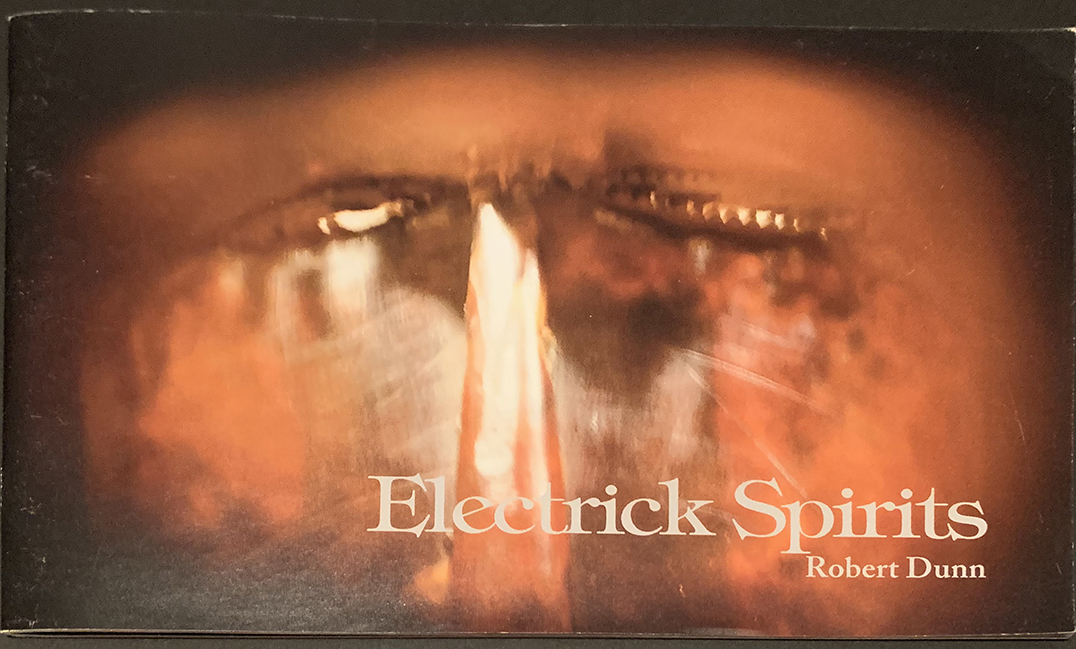
Electrick Spirits by Robert Dunn.
KS- I’ve heard from a number of Artists who are interested in learning how to make a Photobook of their work, and then how to distribute them. Do you have any advice for them?
RD- Well, first off, you can simply do it. That’s key, not to wait around for anyone or anything to tell you how/what to do. Just make a book. Take the pictures, figure out how to lay it out, find somebody to print it, online or at a press … and there it is. You can even make something yourself with a laser printer or Xerox machine and staples. A young friend of mine, Jason Jaworski, is kind of the master of make your own book at home. He prints pages off a regular printer, folds them, makes a cover out of something lying around and cheap, and puts them out. Indeed, our books used to sit next to each other at the ICP Bookstore. I just looked at one. He was selling it for $10, which meant he was probably paying himself $2 an hour, if that.
But he made books, and they got noticed.
In essence, that’s what each of the students in my New School “Writing the Photobook” class do. They simply make their own book.
KS- You’ve used the Fuji X100F exclusively almost since it was released, right?
RD- Actually, my first serious digital camera was the Fuji X100—no “F.” That was their first X100 model, the one I mentioned above. I used it for years, eschewing further iterations of the camera, until I read a piece on the X100F that said that model was finally the perfection of what the X100 started. So I decided to upgrade.
But what I love about both X100s I own is foremost that the camera lets you see what the actual photo will look like through the viewfinder. There’s a little switch on the front that flips you from looking through glass in the viewfinder to actually seeing in it what the lens sees.
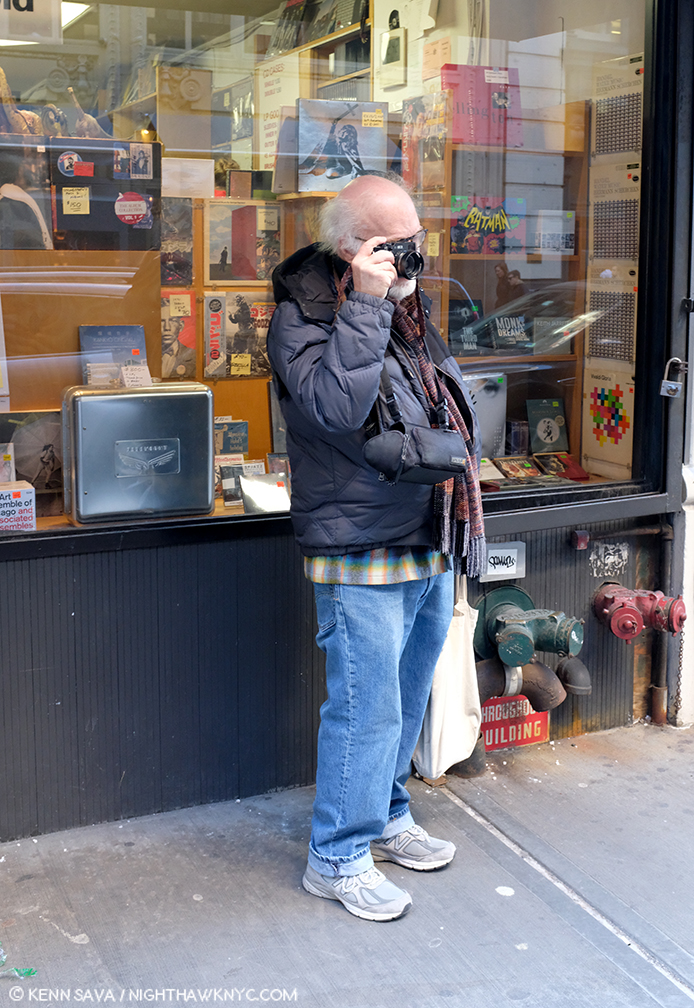
West 18th Street, NYC, February, 2019.
The latter is all-important in my photography. Easily seeing what the lens sees allows me to see the photo itself, with all its blur, contrast, magic intact. So I use that a lot.
I also like that the camera is pretty small and with a fixed focus. I believe in the maxim that if you want to zoom up on something, just get closer. As you can see from many of my photos, I often get very close.
Further, I like it that I can just throw the camera around, grab shots from my hip, or wherever, without having to look through the viewfinder at all. I do that a lot.
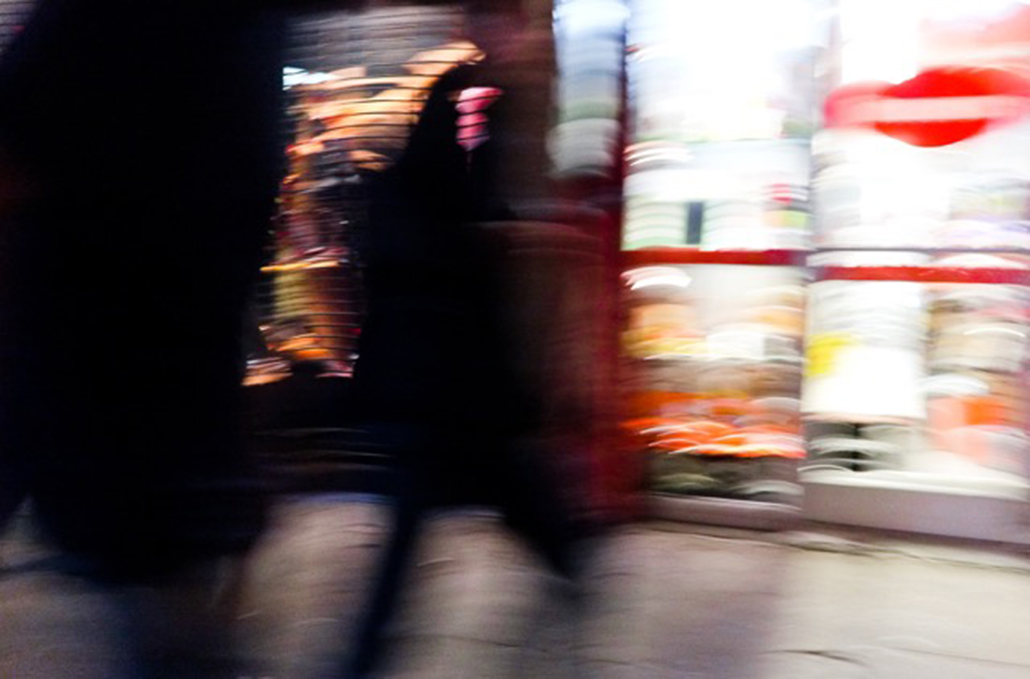
From Demons and Dogs, shortly after Robert got his X100 in 2012.
I’m all about seeing as much as I can on the street, then working to capture it quickly, with full mystery and expressiveness. I’m also about making photobooks in the spirit of: Take lots of photos, all kinds as long as they’re interesting, then sort them out into books later. That’s the novelist in me, I guess. As in the title of my New School class, I want to “write” my photobooks, though personally I never put words into books other than maybe a short preface. By “writing,” I mean giving each book a shape, a logic, a theme, a purpose. That’s what I find in the books I most admire.
KS- To this point, I know that you admire the work of Robert Frank and Daido Moriyama in particular, two Artists who are, it seems, equally celebrated for their Photography and their Photobooks. What is it about each that particularly speaks to you?
RD- My favorite Robert Frank story is told by Garry Winogrand in a Youtube video I watched of Winogrand being interviewed.
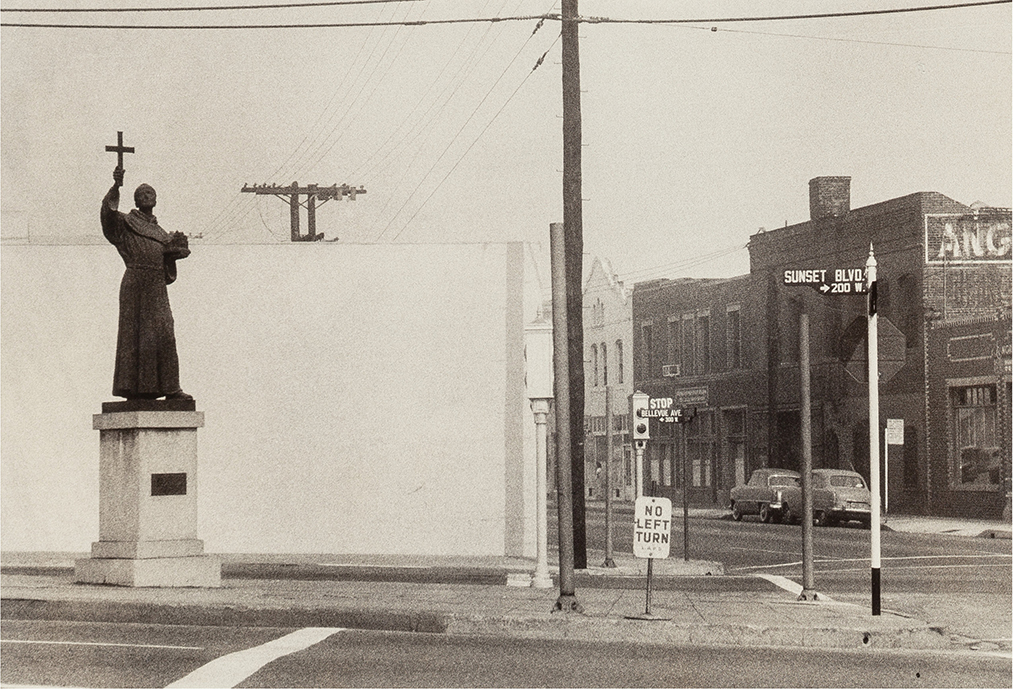
*Garry Winogrand, St.Francis Monument on Sunset Boulevard,1955
He talks about the shot in The Americans of the statue of St. Francis at the foot of Sunset Boulevard in L.A. Winogrand says, “There’s a picture in the Frank book of a statue…. (In 1955, before The Americans came out) I shot that goddamned statue. I made a reasonably good picture of it.
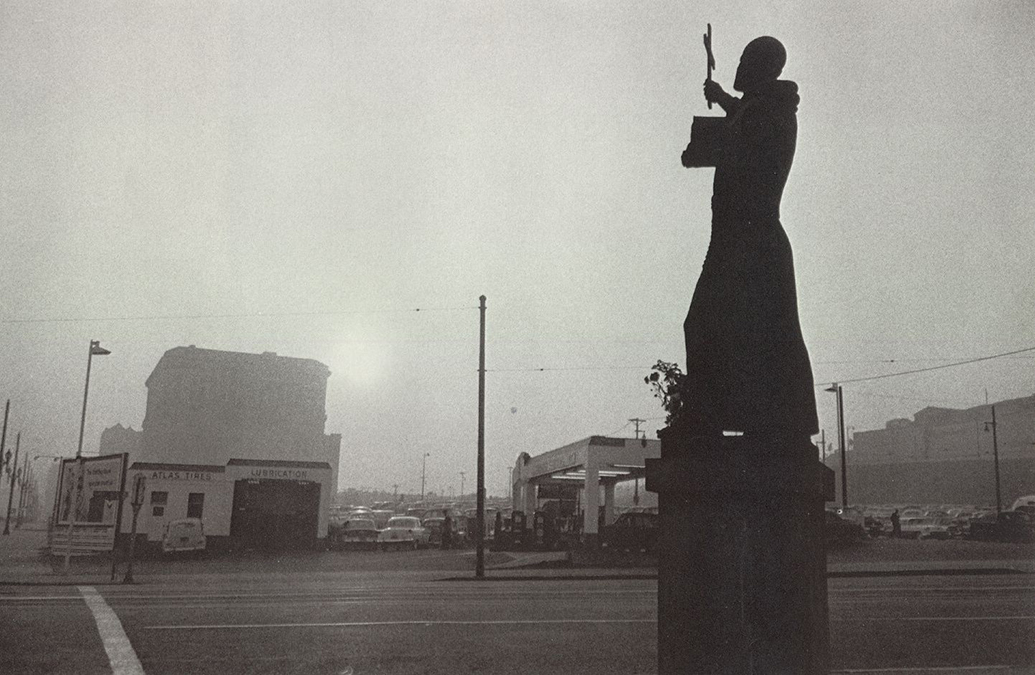
*Robert Frank, St. Francis, Gas Station and City Hall, Los Angeles, 1956
And I saw the Frank book, and it killed it. Put me away six ways, you know…. The picture I made was made. And the picture he made happened. It went whoosh right across the page…. It taught me a hell of a lot. Right off the bat, boom.”
Well, that’s one reason why I like Robert Frank so much: his photos still put me away six ways; they go whoosh across the page; and they teach me a hell of a lot. For some reason, Jimi Hendrix and his “Star-Spangled Banner” is popping into my head, as in, Wait, that’s not how we ever sang it before. That’s a great thing about any art form: one person can blow everything wide open, put us all away six ways … at least six ways.
As for Daido Moriyama, I can still remember the exact moment I found him. I was at the old ICP bookstore, and the clerk, Sarah, becoming a friend and guide, asked me if I knew Daido’s work. I said no, she showed me books of his on the shelves, and I immediately bought one—and kept buying them, till now I have first editions of much of his work.
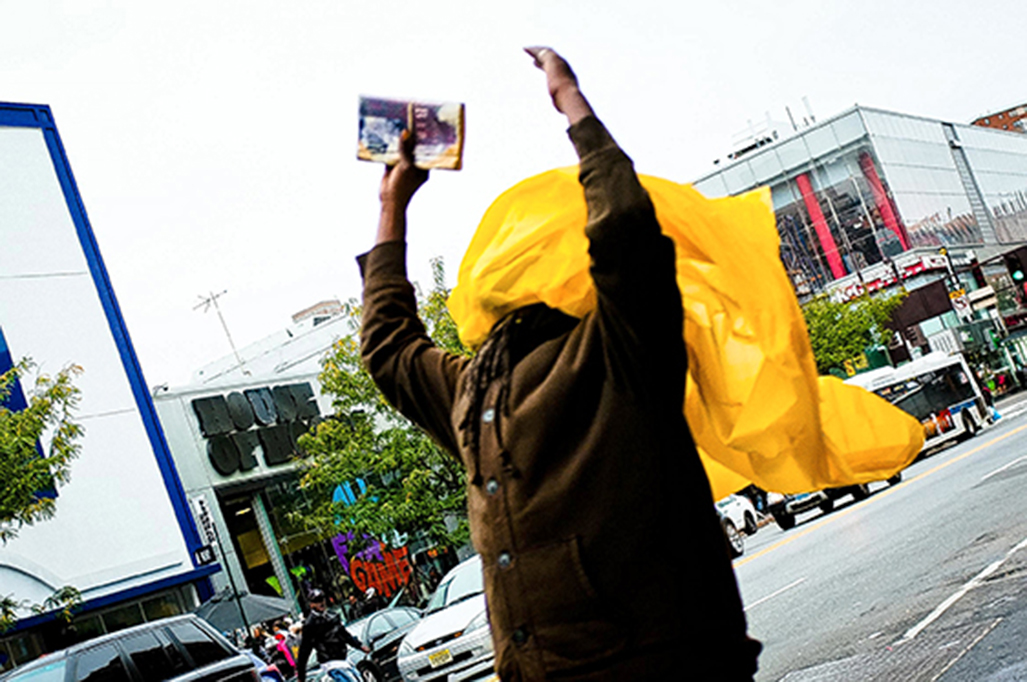
Robert Dunn, From New York Street.
What do I like with Daido? Besides some very strong photos, it’s mostly the freedom to do anything with a photo: have it blurry, scratched, out of focus … everything you’re not supposed to do. Also, that he’s always out on the street prowling for photos, grabbing them everywhere. I have a few photos I’m proud of that are for me just: Look what a strong photo that would make, and, look, I just caught it. One in particular of mine is a photo of a guy in the middle of 125th Street I shot a few years back, in my New York Street book. For some reason he has a long yellow rain slicker over his head and flying back from it, so you can’t see his face. He also has his hands raised high into the air, and in one is a religious tract.
Again, the guy was in the middle of the street. Flash, I saw him, and somehow got my camera around to snap the photo. I like to think my picture, too, wasn’t made. It just happened.
That’s the thing with a lot of Daido’s work, particularly the famous shot of a girl in an alley at night, barefoot in a slip. You know, when you look at any photographer’s work, whoever took the picture was right there. That’s the only way it works. Somebody has a camera, they snap the shutter, they make a picture of what the camera sees. That’s really all it ever is. So it all depends so much on who’s doing the shooting.
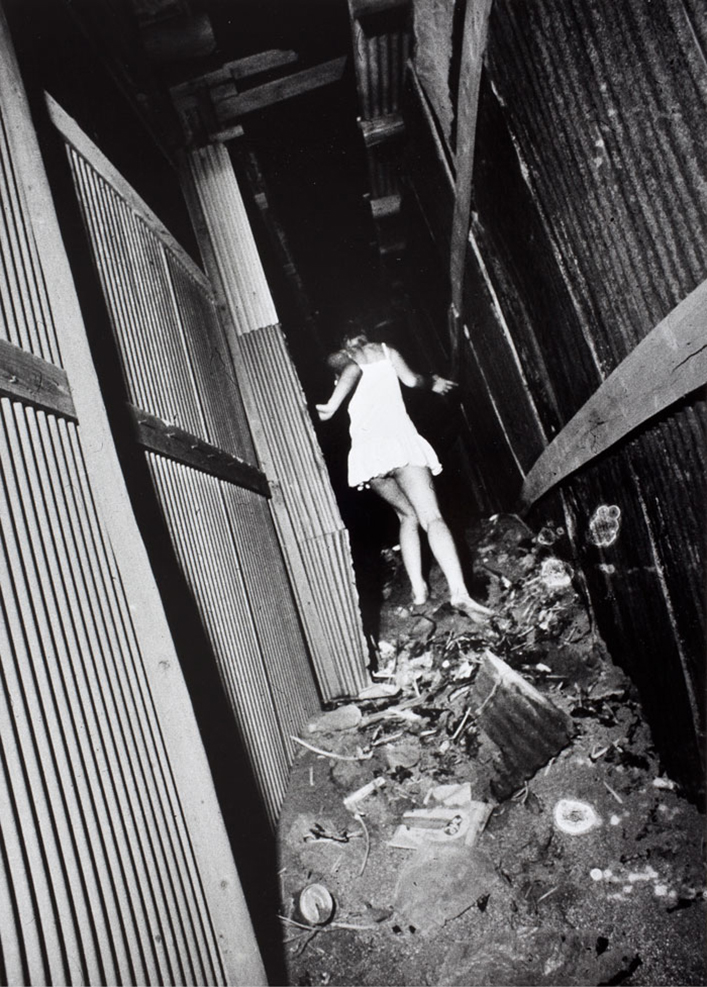
*Daido Moriyama, Untitled (Woman in white dress running), 1971
So I imagine Daido seeing the girl, flipping up his camera, and probably (as I would) feeling some pride in having gotten the shot, even though the angle is crooked and the light screwy. Indeed, that’s the lesson of Moriyama: angles, light, focus … it all means nothing unless you’ve snatched a truly interesting photo from the endless stream.
I also like this particular Daido shot because it engenders a huge story: who’s the girl, how did she get there, why is she barefoot in an alley in a slip, where is she going? Same with my guy in the middle of 125th Street. What he hell is he up to?
KS- Since NHNYC was originally a Painting site, I always ask this: Are there any Painters who’ve influenced you or your Photography, or that particularly speak to you?
RD- I’m especially interested in the play of color in my photos. Also, flows of energy. And deep mystery and spiritual invocation. So off the top of my head, to those ends I’ve learned things from Vermeer, Rothko, Van Gogh, Rembrandt, El Greco—I’m sure there are many more.
KS- Top 5 favorite albums (if you have favorites)? Or, top 5 albums that have influenced you the most?
RD- Record albums, that is, not my grandmother’s mottled leather photo collections? (Smile.)
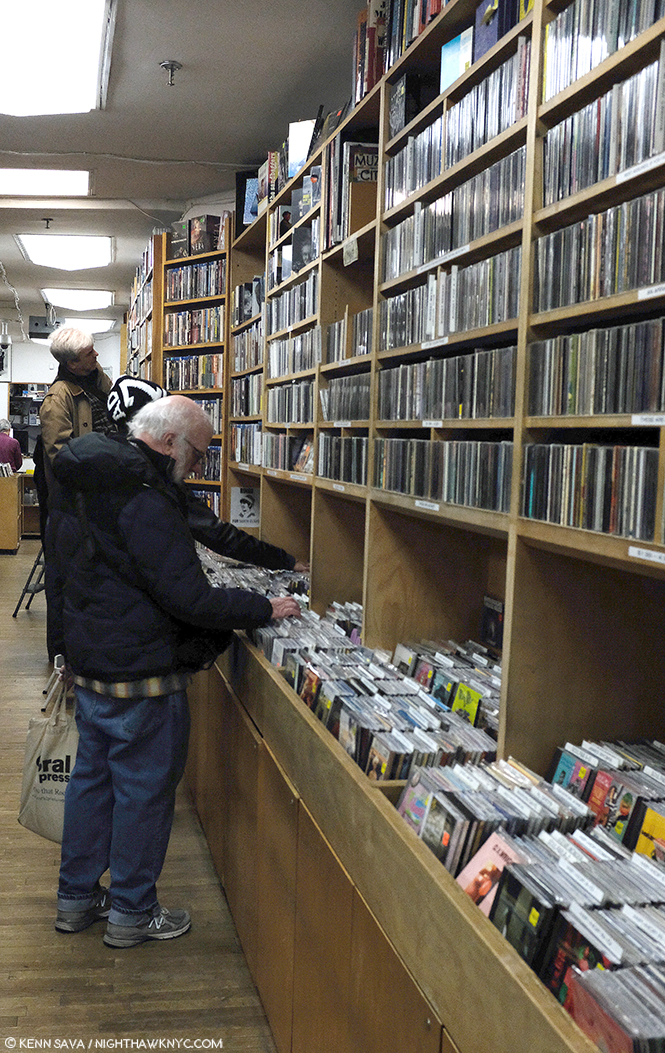
Robert checking out the CD’s at Academy Records, February, 2019
KS- Touche. Yes, Lps, since you have such a carefully curated collection of vinyl.
RD- I’ve been inspired at the deepest level by certain musicians; and in my own deepest understanding of what I’m up to photographically, certain records center me and guide me, though I wouldn’t want to try to articulate just how.
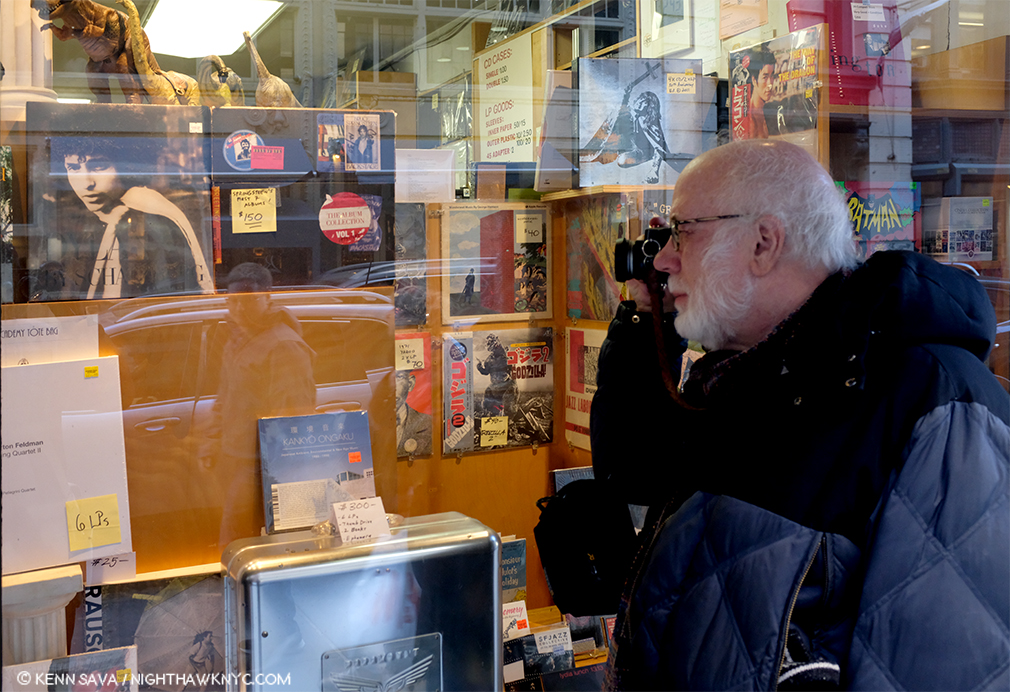
Outside of Academy Records, a PhotoBook of Bob Dylan caught his eye We’ll have to wait until “tomorrow” to see what he made of it.
Top Five of those? Dylan’s Blonde on Blonde and Highway 61 Revisited. The Beatles’ Revolver. John Coltrane’s My Favorite Things. Miles Davis’s Bitches Brew. That’s five, right? Oh, and how about a couple classical LPs: Janos Starker’s Complete Bach Cello Suites, and Glenn Gould’s Bach Goldberg Variations, the 1955 recording.
Again, not necessarily my alltime favorites, but definitely the ones that made me take certain turns with my photography, and that center my work all over again every time I listen to them. It’s all about color, complexity, soul, poetry, and transcendence—in whatever form they take.
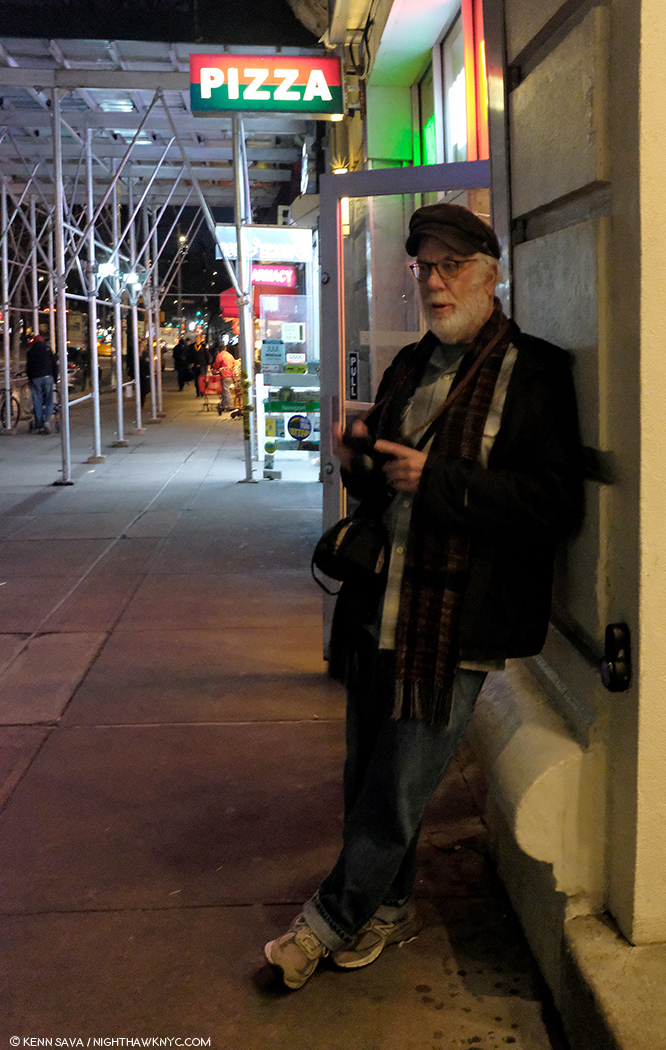
Robert waits to see what tonite brings, getting the jump on tomorrow.
—-End—
Postscript- A few days later, Bob wrote to tell me he’d seen my Stanley Kubrick A Photographer’s Odyssey Post. “Make sure I tell you how my old East Village apartment ended up as a set in one of his movies – for real!,” he said.
Hmmmm…Not able to resist that bait (or anything Kubrick), I immediately asked, “Was that your former apartment in Eyes Wide Shut? Actually, there were at least 2 in that one, but I thought he recreated NYC in London for that. Maybe it’s another Film…?”
He cleared up the mystery- “Good guess – it was Eyes Wide Shut – the East Village prostitute Cruise has the fling with. Long story, but short version is that I was getting thrown out after not actually living there for years. Guy who was there at the time had a photographer pal doing a series of shots of LES apartments, and she had the Kubrick connection. Kubrick flipped over shots of my place, and since I was being cut off the lease, and the landlord was going to gut the place after I was gone, we all met and cut a deal. The Kubrick woman paid a hundred bucks for all the built-in stuff – sink, stove, bathtub – and I got a hundred for my furniture. Then it was all shipped to Shepperton in London – and the film was (finally) finished. So when I see the movie, it’s my sink, my stove, my tub, everything… but the underwear hanging from the ceiling.”
Unfortunately, we’ll never know what Stanley Kubrick would think of Robert Dunn’s Photography. But, at least we know he could spot a fellow classic New Yorker from his furniture.
*- Soundtrack for this Post is “Spanish Key,” by Miles Davis from the legendary landmark album Bitches Brew, 1970. It’s one of my favorites, too, Bob. My recommended “Miles Davis Shortlist” is here.
BookMarks-
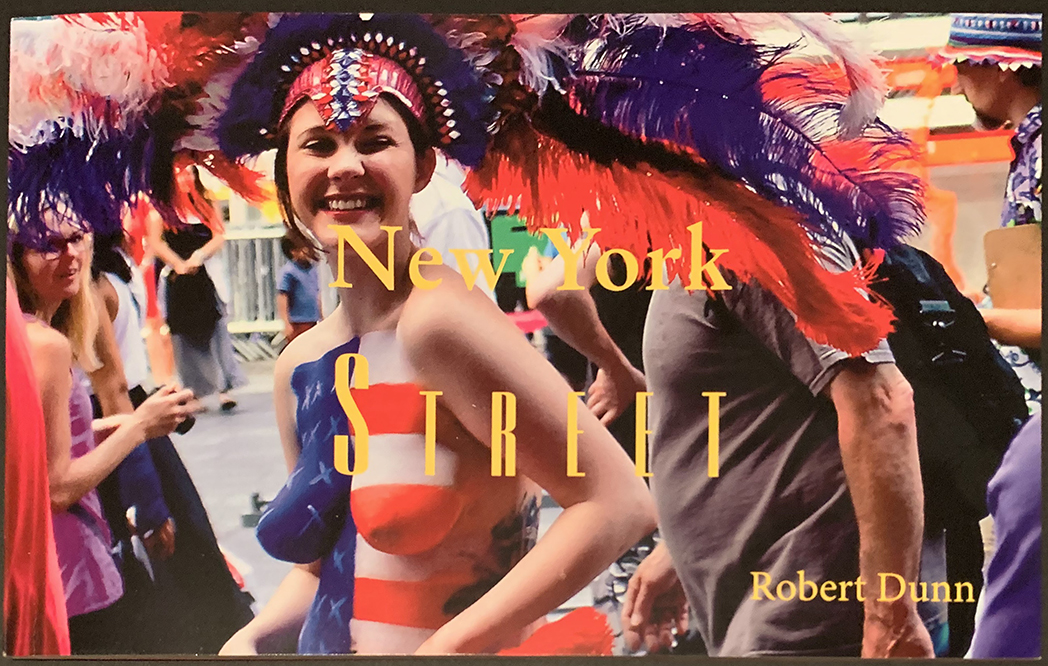
New York Street, a personal favorite, by Robert Dunn.
Robert Dunn’s PhotoBooks are available as follows-
-By mail order, or in store, at Dashwood Books.
-By mail order, or in store, at Printed Matter.
or
–Directly by mail order from Coral Press.
If you have any questions about obtaining them, feel free to write to Coral Press directly, or contact me and I will forward them for you.
My thanks to Robert Dunn.
NighthawkNYC.com has been entirely self-funded and ad-free for over 6 years, during which over 250 full length pieces have been published. If you’ve found it worthwhile, you can donate to keep it going & ad-free below. Thank you!
Written & photographed by Kenn Sava for nighthawknyc.com unless otherwise credited.
To send comments, thoughts, feedback or propositions click here.
Click the white box on the upper right for the archives or to search them.
For “short takes” and additional pictures, follow @nighthawk_nyc on Instagram.
Subscribe to be notified of new Posts below. Your information will be used for no other purpose.
